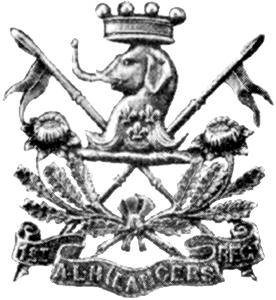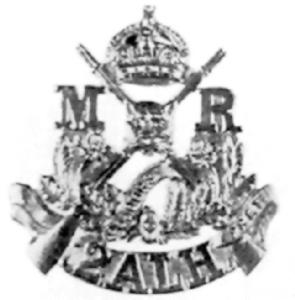Topic: Militia - LHN - 1/7/1
NSWL
New South Wales Lancers
History, 1912 to 1919
New South Wales Lancers [1885 - 1903]
1st (New South Wales Lancers) Australian Light Horse [1903-1912]
7th (New South Wales Lancers) Australian Light Horse [1912-1919]
1st (New South Wales Lancers) Australian Light Horse [1919-1929]
1/21st Australian Light Horse [1929-1935]
1st (Royal New South Wales Lancers) Light Horse Machine Gun Regiment [1936-1942]
1st (Royal New South Wales Lancers) Armoured Regiment [1942-1948]
1st Royal New South Wales Lancers [1948-1956]
1/15th Royal New South Wales Lancers [1956- ]

[The elephant's head used on the badges is taken from the family crest of Lord Carrington, Governor of New South Wales from 1885 - 1890 and was appointed Honorary Colonel of the Regiment from 1885 until 1928.]
Tenax in fide - Steadfast in Trust
Allied with: King Edward's Horse (The King's Overseas Dominions Regiment).
The following history is extracted from Vernon, PV, ed., Royal New South Wales Lancers 1885 to 1985, Sydney 1986, pp. 63 - 79.
Chapter 5 The Regiment 1912 to 1919
Following Lord Kitchener's report on his inspection of the Commonwealth's defences, universal training, often referred to as "compulsory training", was introduced -for cadets from January 1911, and for citizens between the ages of 18 and 26 from July 1912, with exemption for those living in sparsely settled areas.
One of Lord Kitchener's recommendations was the maintenance of 28 regiments of light horse, with a peace establishment per regiment of 29 officers and 350 other ranks and a war establishment of 29 and 470. Except during the Great War period, 1914 to 1918, the percentage of universal trainees in the light horse was small, right up to the suspension of the system in 1929. All other arms were maintained by annual quotas of universal trainees, but in the light horse enrolment was not compulsory, since each recruit was required to provide his own horse, and, while encouragement was given to trainees to enrol, most light horsemen were voluntarily enlisted personnel not liable for compulsory service.
The new system led to the reorganising of most units and the raising of some additional ones. In New South Wales a new regiment, the 28th (Illawarra) Light Horse, was formed, its nucleus being Nos 3 and 5 Squadrons of the N.S.W. Lancers and the Canterbury Half-Squadron of the Mounted Rifles. The designations of all the old regiments were changed, as shown under:
2nd Light Horse Brigade:
Hunter River Lancers: 1903-12 - 4th A.L.H. Regiment; 1912-18 - 6th L.H.
N.S.W. Northern Rivers Lancers: 1903-12 - 5th A.L.H. Regiment; 1912-18 - 4th L.H.
New England Light Horse: 1903-12 - 6th A.L.H. Regiment; 1912-18 - 5th L.H.
3rd (formerly 1st) Light Horse Brigade:
N.S.W. Lancers: 1903-12 - 1st A.L.H. Regiment; 1912-18 - 7th L.H.
N.S.W. Mounted Rifles: 1903-12 - 2nd A.L.H. Regiment; 1912-18 - 9th L.H.
Australian Horse: 1903-12 - 3rd A.L.H. Regiment; 1912-18 - 11th L.H.
The 4th Light Horse was placed antler the 1st Military District, Queensland, for administration and training, and the 28th was attached to the 3rd Light Horse Brigade.
Captain McMahon became second-in-command of the 7th Light Horse (N.S.W. Lancers) on July 1 1912, Captain Vernon taking over Sydney Squadron. Parramatta Squadron at that time was under Captain Stowe. In that same year a Maxim gun section replaced the Colt gun section, and was raised in Sydney under Lieutenant T. R. P. Howard. The first appearance of the gun in the regiment was one day at Victoria Barracks. It was duly placed on the pack-horse and the horse was led to Moore Park Road by the back gate, but on emerging from the barracks it took fright at a milk cart, got out of control and galloped along the road, cannoning into several carts and a telegraph pole, much to the amusement of the onlooking Lancers, and providing material for the wits in the Sydney Squadron for a long time.
As from December 1912 the squadrons of the regiment were designated as follows:
Sydney - "A" Squadron;
Parramatta - "B" Squadron; and,
Windsor, Penrith and Luddenham - "C" Squadron.
The camp of the 3rd Light Horse Brigade in 1913 was at Canberra in order to have the brigade present at the ceremony of the laying of the foundation stone of the Commencement Column by the Governor-General, and the naming of the city, on March 12. The ceremony took place between the sites of the Capitol and. Parliament House, with the four regiments, the 7th, 9th, 11th and 28th, drawn up to form three sides of a hollow square.
In February 1914 the brigade encamped at Tirranna, near Goulburn, the four regiments and detachments of army service corps and army medical corps being present. The brigade was commanded by Colonel J. A. K. Mackay, C.B., and it has been said that this camp was perhaps the best thought out and organised and the most fruitful in results of any in which the regiment had participated up to that time. Generally speaking, the men throughout the brigade had absorbed their previous training, and they now put it into fullest effect.
The next significant occurrence was the advent of the Great War in August 1914. Australia promptly made available naval and military forces to help Great Britain. An expeditionary force, the Australian Imperial Force, was raised. It was a completely separate force from the existing army which was known as the Australian Military Forces, and the two (A.I.F. and A.M.F.) existed as separate and parallel forces until the former was disbanded at the end of the war. Most of the A.M.F. units, including the New South Wales Lancers, remained unchanged in organisation and designation, but the A.I.F. drained from them those men who volunteered and were fit for war.
At the end of August 1914 Major Mackenzie was compelled through ill health to relinquish command, though he offered his services again in any capacity in 1915 and was appointed acting adjutant in April of that year. From September 1914 until March 1921 Major McMahon was in command of the regiment. Although many members left to join the A.I.F., a number of experienced veterans remained, who formed a strong nucleus to train the new recruits brought in to keep up the strength of the regiment, many of the latter being universal trainees. Also, the Lancers, typical of a number of units, provided instructors to assist at light horse training camps for the A.I.F. Early in the war saddlery and some of the rifles were called in as they were required for equipping the A.I.F., and members of the Lancers then had to provide their own saddlery.
The peacetime system of annual eight-day camps lapsed. Public utilities, such as water supply pipelines and bridges, had to be guarded and the regiment did its share with other units in taking up patrol stations. Thus in 1915 the Sydney and Parramatta Squadrons, in turn, each camped for about three weeks at St Ives and patrolled along the coast from Manly to Pittwater. Other mounted regiments also provided detachments to make this patrolling continuous until it was considered unnecessary. In 1916 sub-units were sent in turn to Prospect for three weeks at a time to patrol the water supply pipeline. In 1917 a regimental camp was held at Menangle; horses were not taken but there was some mounted training as remounts were provided. The squadron leaders were: "A", Lieutenant J. Milling; "B", Major F. E. Stowe; "C", Lieutenant R. V. Moore. In "C" Squadron, Windsor Troop was under Lieutenant Molesworth, Penrith Troop under Squadron Quartermaster Sergeant W. R. Veness, and there was no officer at Luddenham. Most of the rank and file were, by now, in age groups called up for universal service. There was no camp in 1918.
From early in the war, regimental full dress fell into disuse, of course. The light horse service dress continued partly in use up to about 1918, but a brown woollen shirt gradually superseded the tunic with white facings and a plain brown hatband replaced the puggaree with white fold. Lancer badges were called in and replaced by oxidised Commonwealth Military Forces badges.
The regimental band was dismounted about the beginning of 1915, and so it remained for ever after. Its grant from the Government was decreased during the war from £150 to £75 per year.
Previous: New South Wales Lancers, Reorganised 1900 to 1912
Next: 1st/7th/1st (New South Wales Lancers) Australian Light Horse
Further Reading:
1st/7th/1st (New South Wales Lancers) Australian Light Horse
New South Wales Lancers, Boer War Contingent
Militia Light Horse, New South Wales
Australian Militia Light Horse
Citation: New South Wales Lancers, 1912 to 1919








